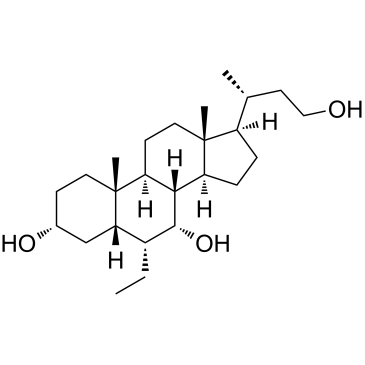| Cas No.: | 1612191-86-2 |
| Chemical Name: | BAR 502,BAR-502,BAR502 |
| Synonyms: | BAR 502,BAR-502,BAR502 |
| SMILES: | CCC1[C@@H]2CC(CC[C@@]2([C@@H]3CC[C@]4([C@H]([C@@H]3C1O)CC[C@@H]4C(C)CCO)C)C)O |
| Formula: | C25H44O3 |
| M.Wt: | 392.62 |
| Sotrage: | 2 years -20°C Powder, 2 weeks 4°C in DMSO, 6 months -80°C in DMSO |
| Publication: | [1]. Festa C, et al. Exploitation of cholane scaffold for the discovery of potent and selective farnesoid X receptor (FXR) and G-protein coupled bile acid receptor 1 (GP-BAR1) ligands. J Med Chem. 2014 Oct 23;57(20):8477-95. [2]. Carino A, et al. BAR502, |
| Description: | BAR502 is a dual FXR and GPBAR1 agonist with IC50 values of 2 μM and 0.4 μM, respectively. |
| In Vivo: | Treatment with BAR502 causes a 10% reduction of b.w., increases insulin sensitivity and circulating levels of HDL, while reduces steatosis, inflammatory and fibrosis scores and liver expression of SREPB1c, FAS, PPARγ, CD36 and CYP7A1 mRNA. BAR502 increases the expression of SHP and ABCG5 in the liver and SHP, FGF15 and GLP1 in intestine. BAR502 promotes the browning of epWAT and reduces liver fibrosis induced by CCl4[2]. In models of non-obstructive cholestasis, BAR502 attenuates liver injury without causing itching. Co-treatment with BAR502 increases survival, attenuates serum alkaline phosphatase levels and robustly modulates the liver expression of canonical FXR target genes including OSTα, BSEP, SHP and MDR1, without inducing pruritus[3]. |
| In Vitro: | BAR502 is a truncated side chain alcohol with both substituents on ring B in α-configuration. At the concentration of 10 μM, BAR502 fails to transactivate GR, PPARγ, and LXR, respectively, but it transactivates the nuclear receptor PXR. BAR502 is able to induce the expression of pro-glucagon mRNA in GLUTAg cells, an intestinal endocrine cell line, as well as to increase cAMP concentrations in THP-1 cells. BAR502 induces the expression of OSTα, BSEP, and SHP in HepG2 cells. BAR502 shows a very potent activity in the recruitment of SRC-1 coactivator and high affinity to FXR[1]. |

 To enhance service speed and avoid tariff delays, we've opened a US warehouse. All US orders ship directly from our US facility.
To enhance service speed and avoid tariff delays, we've opened a US warehouse. All US orders ship directly from our US facility.




















